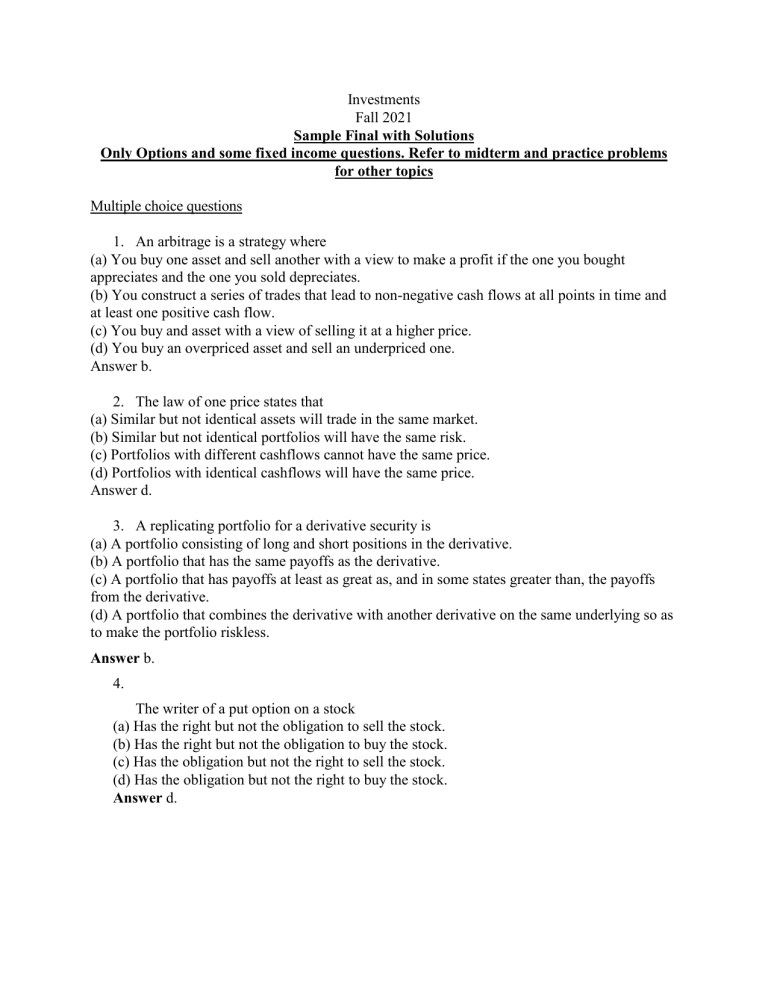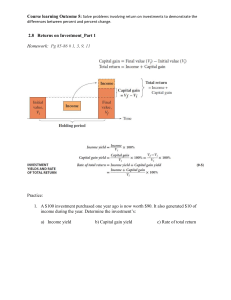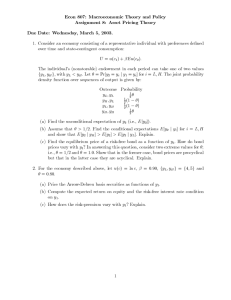
Investments Fall 2021 Sample Final with Solutions Only Options and some fixed income questions. Refer to midterm and practice problems for other topics Multiple choice questions 1. An arbitrage is a strategy where (a) You buy one asset and sell another with a view to make a profit if the one you bought appreciates and the one you sold depreciates. (b) You construct a series of trades that lead to non-negative cash flows at all points in time and at least one positive cash flow. (c) You buy and asset with a view of selling it at a higher price. (d) You buy an overpriced asset and sell an underpriced one. Answer b. 2. The law of one price states that (a) Similar but not identical assets will trade in the same market. (b) Similar but not identical portfolios will have the same risk. (c) Portfolios with different cashflows cannot have the same price. (d) Portfolios with identical cashflows will have the same price. Answer d. 3. A replicating portfolio for a derivative security is (a) A portfolio consisting of long and short positions in the derivative. (b) A portfolio that has the same payoffs as the derivative. (c) A portfolio that has payoffs at least as great as, and in some states greater than, the payoffs from the derivative. (d) A portfolio that combines the derivative with another derivative on the same underlying so as to make the portfolio riskless. Answer b. 4. The writer of a put option on a stock (a) Has the right but not the obligation to sell the stock. (b) Has the right but not the obligation to buy the stock. (c) Has the obligation but not the right to sell the stock. (d) Has the obligation but not the right to buy the stock. Answer d. 2 5. You have a long position in a stock that you purchased for $100, and a short position in a put option on the same stock at strike K = 100. At maturity the stock price is $95, and you liquidate your stock and option positions. Your gross payoff (cash flow) is (a) $0 (b) $5 (c) $90 (d) $95 Answer c 6. You have a long position in a stock that you purchased for $100, a short position in a call and a long position in a put, both at strike K = 100. At maturity the stock price is ST, and you liquidate your stock and option positions. Your gross payoff (cash flow) is (a) 0 (b) ST.– 100 (c) 100 (d) 100 – ST Answer c. The cashflow on liquidating the position is + ST – max (0, ST – K) +max (0, K – ST) = K = 100. 7. The 90–, 100–, and 110–strike calls are trading at $12, $5, $3, respectively. The stock price is at $100. What is the maximum net payoff on a long butterfly spread using these options? (a) $5 (b) $0 (c) $5 (d) $10 Answer c. The butterfly spread is C (90) 2C (100) C (110) for a net premium paid of $5. The highest gross payoff is when ST = 100 , i.e., a payoff of $10. Hence, the maximum net payoff is $5. 8. In a one-period binomial model, assume that the current stock price is $100, and that it will rise to $110 or fall to $90 after one month. If the risk-free rate is 0.1668% per month in simple terms, which of the following choices best describes the replicating portfolio for one hundred 99-strike one-month call options? (a) Long 50 shares of stock and long 50 units of $1 bonds. (b) Long 55 shares of stock and long 49 units of $1 bonds. (c) Long 55 shares of stock and short 49 units of $1 bonds. 3 (d) Long 55 shares of stock and short 50 units of $1 bonds. Answer c. We solve the following two equations to get the replicating portfolio of X shares of stock and Y units of risk-free bond: 11 = 110 X 1.001668Y 0 = 90 X 1.001668Y We get X =11/20 = 0.55 , and Y = 49.41757 . 9. The current price of a stock is $100. What is the Black-Scholes model price of a sixmonth put option at strike $98, given an interest rate of 2% and a dividend rate of 1%? The volatility is 45%. (a) $11.02 (b) $11.22 (c) $11.68 (d) $11.73 Answer b. Calculated using the Black-Scholes formula 10. As the yield increases, the duration of a risk-free, coupon paying bond will a. Increase b. Stay the same c. Decrease d. Not enough information to tell As the yield increases, a greater percentage of the bond value is associated with the earlier payments because the present values of the later payments are more sensitive to the discount rate. Thus, duration decreases. 11. All else equal, if the risk-free rate falls, then the value of an at-the-money, European put option will e. Decrease f. Stay the same g. Increase h. Not enough information to tell For puts, the strike price is a cash inflow (revenue). As the risk-free rate falls, the PV of this cash flow increases, and the put value increases. 12. If the price of a bond will increase by 7.3% for a 1% drop in yield, then for a 1% increase in yield the price will fall i. Less than 7.3% j. More than 7.3% 4 k. 7.3% l. Not enough information to tell Bond prices are convex; therefore, the decrease in price is lower than increase for a change in yield of the same magnitude. 13. For a storable commodity with zero storage costs and assuming a 0% interest rate, the forward price m. Will be greater than the spot price n. Cannot be greater than the spot price o. Is definitely equal to the spot price p. Not enough information to tell The no-arbitrage relation is F0 S0 (1 rf s)T S0 . Therefore, the forward price must be less than or equal to the spot price. 14. Under Black-Scholes and assuming a continuously compounded risk-free rate of 4%, the value of a 1-year call option with an exercise price of $40 (X=40) on a non-dividend paying stock with a price of $50 (S0=50), is q. Less than $10 r. Between $10 and $11.50 s. More than $11.50 t. Not enough information to tell The call price always exceeds adjusted intrinsic value C0 max( 0, S0 Xe rT ) 50 40e 0.04 11.57 15. If a 7-year bond is currently selling at a premium (i.e., for more than its par or face amount), then, if the yield remains the same, the price over the next year will u. Rise v. Fall w. Stay the same x. Not enough information to tell Over time, the price must converge to par (face amount). Therefore, if the yield doesn’t change, the price of a premium bond must fall. 16. If you buy a 5-year, 4% coupon, annual pay bond at a yield of 3.5%, hold it for 3 years while reinvesting the coupon payments at 2.5%, and then sell it when the yield on the 2year bond is 4%, your annual HPR is y. Less than 2.5% z. More than 3.5% aa. Between 2.5% and 3.5% bb. Not enough information to tell 5 The initial YTM is 3.5%. You sell after the yield has risen to 4%, thus the HPR (ignoring reinvestment) is less than 3.5%. In fact, it will be approximately 3.17%, because earning 3.17% for 3 years, then 4% for 2 years is equivalent to earning 3.5% for 5 years. You earn 2.5% on your reinvestment, so the total HPR is somewhere between 3.17% and 2.5%. 17. Under the liquidity preference theory, if the term structure of interest rates (yield curve) is upward sloping, then investors expect short-term rates to cc. Increase in the future dd. Stay the same ee. Decrease in the future ff. Not enough information to tell Under the LPT, long bonds contain a (positive) risk premium. Thus, an upward sloping yield curve is not necessarily associated with increasing expected short-term rates. 18. If the volatility of the stock increases, holding all other factors constant, the value of a portfolio that is long a call and short a put, both with the same exercise price and maturity, a. Increases b. Decreases c. Stays the same d. Not enough information to tell Under put-call parity, call minus put equals stock minus bond. Since the values of neither the stock nor the bond depend (directly) on volatility, the increase in the call price must be perfectly offset by the increase in the put price. 19. A bond currently has a price of $1,000, a yield of 5% and a Macaulay duration of 6 years. If the yield changes to 5.10% what will be the new price (based on the duration approximation)? a. 994.29 b. 942.86 c. 994.00 d. 1,006.00 ΔP/P=[-D/(1+y)]Δy=[-6/(1+5%)]0.1%=-0.57% so the new price is 1,000(10.57%)=994.29



